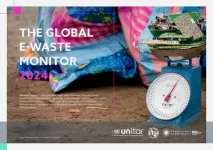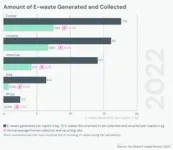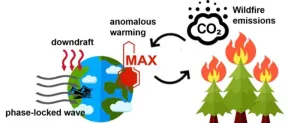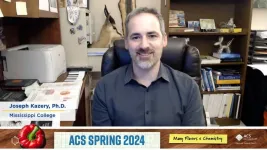(Press-News.org) Geneva / Bonn - The world's generation of electronic waste is rising five times faster than documented e-waste recycling, the UN's fourth Global E-waste Monitor (GEM) reveals today.
The 62 million tonnes of e-waste generated in 2022 would fill 1.55 million 40-tonne trucks, roughly enough trucks to form a bumper-to-bumper line encircling the equator, according to the report from ITU and UNITAR.
Meanwhile, less than one quarter (22.3%) of the year's e-waste mass was documented as having been properly collected and recycled in 2022, leaving US$ 62 billion worth of recoverable natural resources unaccounted for and increasing pollution risks to communities worldwide.
Worldwide, the annual generation of e-waste is rising by 2.6 million tonnes annually, on track to reach 82 million tonnes by 2030, a further 33% increase from the 2022 figure.
E-waste, any discarded product with a plug or battery, is a health and environmental hazard, containing toxic additives or hazardous substances such as mercury, which can damage the human brain and coordination system.
The report predicts a drop in the documented collection and recycling rate from 22.3% in 2022 to 20% by 2030 due to the widening difference in recycling efforts relative to the staggering growth of e-waste generation worldwide.
Challenges contributing to the widening gap include technological progress, higher consumption, limited repair options, shorter product life cycles, society's growing electronification, design shortcomings, and inadequate e-waste management infrastructure.
The report outlines that if countries could bring the e-waste collection and recycling rates to 60% by 2030, the benefits - including through minimizing human health risks - would exceed costs by more than US $38 billion.
As well, it says the world “remains stunningly dependent” on a few countries for rare earth elements, despite their unique properties crucial for future technologies, including renewable energy generation and e-mobility.
Additional data highlights are appended.
Comments
“Amidst the hopeful embrace of solar panels and electronic equipment to combat the climate crisis and drive digital progress, the emergence in e-waste requires urgent attention.” Nikhil Seth, Executive Director, UNITAR
“From discarded televisions to dumped telephones, an enormous amount of e-waste is generated around the world. The latest research shows that the global challenge posed by e-waste is only going to grow. With less than half of the world implementing and enforcing approaches to manage the problem, this raises the alarm for sound regulations to increase collection and recycling. The Global E-waste Monitor is the world's foremost source for e-waste data allowing us to track progress overtime and to make critical decisions when it comes to transitioning to a circular economy for electronics.” Cosmas Luckyson Zavazava, Director, ITU Telecommunication Development Bureau
“No more than 1% of demand for essential rare earth elements is met by e-waste recycling. Simply put: Business as usual can't continue. This new report represents an immediate call for greater investment in infrastructure development, more promotion of repair and reuse, capacity building, and measures to stop illegal e-waste shipments. And the investment would pay for itself in spades.” Kees Baldé, lead author, UNITAR
“Many in today's society use multiple computers and phones, an ever-growing number of new appliances, monitors and sensors, e-bikes, e-scooters, clothes, toys, and furniture with embedded electronics, electric tools, and energy-saving equipment such as LEDs, photovoltaics, and heat pumps. Urban and remote areas are increasingly connected to the Internet, and a growing number of data centers cater to the needs of the digital transformation. In the face of all this, concrete steps are urgently needed to address and reduce e-waste. Improved e-waste management could result in a global net positive of US $38 billion, representing a significant economic opportunity while addressing climate change and health impacts.” Ruediger Kuehr, Senior Manager, Sustainable Cycles (SCYCLE) Programme, UNITAR / Adjunct Professor, University of Limerick (Ireland)
The Global E-waste Monitor shows that we are currently wasting US $91 billion in valuable metals due to insufficient e-waste recycling. We must seize the economic and environmental benefits of proper e-waste management; Otherwise, the digital ambitions of our future generations will face significant risks.” Vanessa Gray, Head, Environment & Emergency Telecommunications Division, ITU Telecommunication Development Bureau
*******
By the numbers:
* 62 million tonnes: e-waste generated in 2022, equal to the weight of 107,000 of the world's largest (853-seat), heaviest (575 tonne) passenger aircraft – enough to form an unbroken queue from New York to Athens, from Nairobi to Hanoi , or from Hong Kong to Anchorage
* 14 million tonnes (22.3%): estimated mass of e-waste trashed, mostly landfilled, in 2022
* 31 million tonnes: estimated weight of metals embedded in e-waste in 2022, along with 17 million tonnes of plastics and 14 million tonnes of other materials (minerals, glass, composite materials, etc.)
* US $91 billion: The value of metals embedded in 2022 e-waste, including US $19 billion in copper, US $15 billion in gold, and US $16 billion in iron.
* US $28 billion: value of secondary raw materials (mostly iron) reclaimed by “urban mining” of e-waste in 2022
* 900 million tonnes: Primary ore extraction avoided by reclaiming materials through documented e-waste recycling
* 93 million tonnes: CO2-equivalent emissions avoided by formal e-waste management – recaptured refrigerants (41 million tonnes), avoided metals mining (52 million tonnes)
Recycling rates
* 42.8%: Formally documented collection and recycling rates in Europe
* <1%: Formally recycled e-waste in African countries
* ~50% (30 million tonnes): E-waste generated by Asian countries (of which relatively few have enacted legislation or established clear e-waste collection targets)
* 17.6 kg: Per capita e-waste generation in Europe, followed by Oceania (16.1 kg) and the Americas (14.1 kg). These regions also have the highest documented per capita collection and recycling rates (7.5 kg in Europe, 6.7 kg in Oceania and 4.2 kg in the Americas)
* 16 million tonnes: e-waste collected and recycled outside of formal systems in high- and upper-middle income countries that have developed e-waste management infrastructure.
* 18 million tonnes: e-waste managed mostly by the informal sector in low and lower-middle income countries with no e-waste management infrastructure. Any material values recovered by the informal sector are largely (perhaps more than) offset by extremely high health and environmental costs
* 5.1 million tonnes (8.2% of the global total): e-waste shipped across borders in 2022, of which ~3.3 million tonnes (65%) was shipped from high-income to middle- and low-income countries through uncontrolled, undocumented movements
E-waste by category, selected examples
* 33% (20.4 million tonnes): Proportion of e-waste made up of small devices (eg toys, microwave ovens, vacuum cleaners, e-cigarettes), of which 12% are recycled
* 4.6 million tonnes: e-waste in the small IT and telecommunications equipment category (eg laptops, mobile phones, GPS devices, routers), with only 22% documented collection and recycling rate
* 2.4 million tonnes: Expected mass of retired photovoltaic panels in 2030, four times as much as the 600,000 tonnes in 2022
Among the report's many observations:
* Typically, collection and recycling rates are highest for heavier and bulkier equipment categories, such as large devices, temperature exchange equipment, screens and monitors.
* 81 countries had e-waste legislation in 2023, up from 78 in 2019. Of the 81 countries, 67 had a legal instrument governing e-waste management with provisions promoting extended producer responsibility (EPR)
* The enforcement of e-waste policy, legislation, and regulation “remains a genuine challenge globally, and the stagnation of the global e-waste collection and recycling rate is likely exacerbated by the fact that only 46 countries have collection rate targets and only 36 have recycling rate targets.”
* * * * *
The Global E-waste Monitor
Since 2014, the Global E-waste Monitor (www.globalwaste.org) has been the world’s foremost source of up-to-date data and reporting on progress in policy, regulation, and offering projections.
The 2024 edition is a collaborative product of the Global E-waste Statistics Partnership with support from the Fondation Carmignac.
Earlier global and regional reports: https://ewastemonitor.info
Join the conversation on social media using hashtag #eWaste
* * * * *
The UN Institute for Training and Research (UNITAR) (unitar.org)
As a dedicated training arm of the United Nations System, the United Nations Institute for Training and Research (UNITAR) provides innovative learning solutions to individuals, organizations and institutions to enhance global decision-making and support country-level action for shaping a better future. UNITAR was created in 1963 to train and equip young diplomats from newly independent UN Member States with the knowledge and skills needed to navigate through the diplomatic environment. Over the years, UNITAR has acquired unique expertise and experience in designing and delivering a variety of training and learning activities, benefiting learners mainly from developing countries. With the strategy fully aligned with the 2030 Agenda, we support Governments and other stakeholders to achieve Sustainable Development Goals.
The Bonn, Germany-based Sustainable Cycles (SCYCLE) Programme, hosted by UNITAR, provides world-class research and action on e-waste. SCYCLE aims to enable societies to reduce the environmental burden caused by the production, consumption and disposal of ubiquitous goods.
The International Telecommunication Union (itu.int)
The International Telecommunication Union (ITU) is the United Nations specialized agency for information and communication technologies (ICTs), driving innovation in ICTs together with 193 Member States and a membership of over 1,000 companies, universities, and international and regional organizations. Established in 1865, it is the intergovernmental body responsible for coordinating the shared global use of the radio spectrum, promoting international cooperation in assigning satellite orbits, improving communication infrastructure in the developing world, and establishing the worldwide standards that foster seamless interconnection of a vast range of communications systems. From broadband networks to cutting-edge wireless technologies, aeronautical and maritime navigation, radio astronomy, oceanographic and satellite-based earth monitoring as well as converging fixed-mobile telephone, Internet and broadcasting technologies, ITU is committed to connecting the world.
Carmignac Foundation (fondationcarmignac.com)
Fondation Carmignac was founded in 2000 by Edouard Carmignac, a French entrepreneur, CEO and Chairman of asset management company Carmignac. Today, it is structured around three main pillars: the Carmignac Photojournalism Award, which annually funds the production of investigative photo reportage on human rights violations and geo-strategic issues, the Carmignac Collection, which has over 300 works of contemporary art, and Villa Carmignac , an art venue offering annual exhibitions and a rich cultural program in a 2000-square-meter gallery set in a 15-hectare estate at the heart of a protected site on Porquerolles island.
Fondation Carmignac contributes to the Global E-waste Monitor photographs by laureates of the 13th edition of the Carmignac Photojournalism Award. Investigative journalist Anas Aremeyaw Anas and photojournalists Muntaka Chasant and Bénédicte Kurzen explore the complexities of e-waste trafficking from European ports to Ghana scrapyards, its revealing complexity, globalized cycle and highlighting the opportunities and environmental impact of the e-waste economy.
END
Electronic waste rising five times faster than documented e-waste recycling: UN
Record 62 million tonnes of e-waste produced in 2022, up 82% since 2010; On track to rise further 32% in 2030; $billions worth of strategically-valuable resources squandered; Just 1% of rare element demand met by recycling
2024-03-20
ELSE PRESS RELEASES FROM THIS DATE:
JAMA Network names new editor in chief of JAMA Network Open
2024-03-20
Chicago, March 20, 2024 – Eli Perencevich, M.D., M.S., has been named the Editor in Chief of JAMA Network Open. Dr. Perencevich is the Associate Chair for Clinical and Health Services Research and Professor of Internal Medicine at the University of Iowa Carver College of Medicine, and the Director of the Center for Access & Delivery Research and Evaluation (CADRE) at the Iowa City VA Medical Center.
With over 20 years of experience studying the epidemiology and outcomes of hospital-acquired infections using mathematical ...
Scientists uncover a causal relationship between remote extreme heat and the Canadian wildfires in 2023
2024-03-20
Wildfires are events that can have significant impacts on ecosystems and human society. In the context of global warming, there has been a notable surge in the frequency and ferocity of wildfires in the Northern Hemisphere over recent years. In 2023, Canada experienced an unprecedented wildfire event, with CO2 emissions increasing by 527.1% over the average of 2001–2022 during the months of May–August. The burned area was more than 6–7 times larger than in a normal year. Notably, both Canada and more than 15 states in the northeastern ...
Crawfish could transfer ionic lithium from their environment into food chain
2024-03-20
NEW ORLEANS, March 20, 2024 — From cell phones to watches to electric cars, lithium-ion rechargeable batteries power a plethora of devices. The increased use of this technology means more lithium could find its way into the environment as consumers discard electronic products. Now, researchers describe how lithium can accumulate in a common Southern crustacean: the crawfish. As the season for catching and eating mudbugs comes into full swing, the researchers’ findings highlight the potential implications for public health and the environment.
The researchers will present ...
Teaching teenagers to understand their feelings is key to life-long resilience, psychologist says
2024-03-20
Helping teenagers to understand what is going on inside their own brains is the key to helping them mature into resilient and independent adults, research suggests.
Sheila Redfern, a consultant clinical child and adolescent psychologist, proposes that rather than focusing on stamping out difficult behaviours, parents should teach teenagers to manage their feelings and relationships in safe ways.
Dr. Redfern says that although parenting teenagers is uniquely challenging, with concerns about social media use, self-harm, ...
Visionary $15 million gift from Wayne & Wendy Holman to NYU Langone Health ensures continued excellence in newly named Holman Division of Endocrinology, Diabetes & Metabolism
2024-03-20
NYU Langone Health has received a $15 million gift from innovators and philanthropists Wayne G. Holman, MD, and Wendy Holman to further elevate the world-class treatment and study of endocrine disorders in the newly named and endowed Holman Division of Endocrinology, Diabetes & Metabolism.
“Wayne and Wendy’s generosity in this important area of medicine will help NYU Langone further enhance our exceptional research, education and clinical care within the Holman Division of Endocrinology, ...
Rural and minority dementia patients face disparities in access to neurologists
2024-03-20
SPOKANE, Wash.—Getting dementia diagnosed can be a long and difficult process for anyone, but some may face additional challenges based on race or ethnicity and where they live, according to a study led by Washington State University researchers.
The study of nearly 95,000 Washington state residents found that people living outside of urban areas as well as Native American and Hispanic people face longer travel distances to be seen by neurologists. The researchers said these disparities could be contributing to delayed diagnoses, which can result in higher costs of care, ...
Fish fed to farmed salmon should be part of our diet, too, study suggests
2024-03-20
Paper available at: https://drive.google.com/drive/folders/144cIFPtY2VSaqV8AfFHy_hh6xlDcLShy?usp=sharing
The public are being encouraged to eat more wild fish, such as mackerel, anchovies and herring, which are often used within farmed salmon feeds. These oily fish contain essential nutrients including calcium, B12 and omega-3 but some are lost from our diets when we just eat the salmon fillet.
Scientists found that farmed salmon production leads to an overall loss of essential dietary nutrients. They say that eating more wild ‘feed’ species directly could benefit our health while reducing aquaculture demand for finite marine resources.
Researchers analysed ...
AI ethics are ignoring children, say Oxford researchers
2024-03-20
Researchers from the Oxford Martin Programme on Ethical Web and Data Architectures (EWADA), University of Oxford, have called for a more considered approach when embedding ethical principles in the development and governance of AI for children.
In a perspective paper published today in Nature Machine Intelligence, the authors highlight that although there is a growing consensus around what high-level AI ethical principles should look like, too little is known about how to effectively apply them in principle for children. The study mapped the global landscape of existing ethics guidelines for AI and identified four ...
Cleaning up environmental contaminants with quantum dot technology
2024-03-20
NEW ORLEANS, March 20, 2024 — The 2023 Nobel Prize in Chemistry was focused on quantum dots — objects so tiny, they’re controlled by the strange and complex rules of quantum physics. Many quantum dots used in electronics are made from toxic substances, but their nontoxic counterparts are now being developed and explored for uses in medicine and in the environment. One team of researchers is focusing on carbon- and sulfur-based quantum dots, using them to create safer invisible inks and to help decontaminate water supplies.
The researchers will present their results today at the spring meeting of the ...
New model clarifies why water freezes at a range of temperatures
2024-03-20
NEW ORLEANS, March 20, 2024 — From abstract-looking cloud formations to roars of snow machines on ski slopes, the transformation of liquid water into solid ice touches many facets of life. Water’s freezing point is generally accepted to be 32 degrees Fahrenheit. But that is due to ice nucleation — impurities in everyday water raise its freezing point to this temperature. Now, researchers unveil a theoretical model that shows how specific structural details on surfaces can influence water’s freezing point.
The researchers will present their results at the spring meeting of the American Chemical Society (ACS). ACS Spring 2024 is a hybrid meeting being held virtually ...
LAST 30 PRESS RELEASES:
Making lighter work of calculating fluid and heat flow
Normalizing blood sugar can halve heart attack risk
Lowering blood sugar cuts heart attack risk in people with prediabetes
Study links genetic variants to risk of blinding eye disease in premature infants
Non-opioid ‘pain sponge’ therapy halts cartilage degeneration and relieves chronic pain
AI can pick up cultural values by mimicking how kids learn
China’s ecological redlines offer fast track to 30 x 30 global conservation goal
Invisible indoor threats: emerging household contaminants and their growing risks to human health
Adding antibody treatment to chemo boosts outcomes for children with rare cancer
Germline pathogenic variants among women without a history of breast cancer
Tanning beds triple melanoma risk, potentially causing broad DNA damage
Unique bond identified as key to viral infection speed
Indoor tanning makes youthful skin much older on a genetic level
Mouse model sheds new light on the causes and potential solutions to human GI problems linked to muscular dystrophy
The Journal of Nuclear Medicine ahead-of-print tip sheet: December 12, 2025
Smarter tools for peering into the microscopic world
Applications open for funding to conduct research in the Kinsey Institute archives
Global measure underestimates the severity of food insecurity
Child survivors of critical illness are missing out on timely follow up care
Risk-based vs annual breast cancer screening / the WISDOM randomized clinical trial
University of Toronto launches Electric Vehicle Innovation Ontario to accelerate advanced EV technologies and build Canada’s innovation advantage
Early relapse predicts poor outcomes in aggressive blood cancer
American College of Lifestyle Medicine applauds two CMS models aligned with lifestyle medicine practice and reimbursement
Clinical trial finds cannabis use not a barrier to quitting nicotine vaping
Supplemental nutrition assistance program policies and food insecurity
Switching immune cells to “night mode” could limit damage after a heart attack, study suggests
URI-based Global RIghts Project report spotlights continued troubling trends in worldwide inhumane treatment
Neutrophils are less aggressive at night, explaining why nighttime heart attacks cause less damage than daytime events
Menopausal hormone therapy may not pose breast cancer risk for women with BRCA mutations
Mobile health tool may improve quality of life for adolescent and young adult breast cancer survivors
[Press-News.org] Electronic waste rising five times faster than documented e-waste recycling: UNRecord 62 million tonnes of e-waste produced in 2022, up 82% since 2010; On track to rise further 32% in 2030; $billions worth of strategically-valuable resources squandered; Just 1% of rare element demand met by recycling








